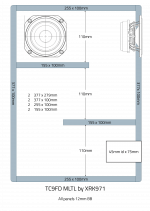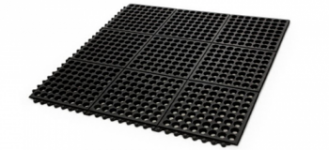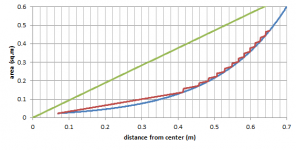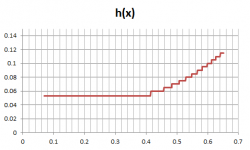As long as varnish is not solvent containing that would melt foam. The paper is absorbent and if absorbs solvent will delaminate. This happened to me with liquid nails. There are two kinds. One with volatile solvents and a water based one. Can't use VOC based one.
To sidestep any worry about solvents, one could use chunks of floormat / nonslip tiling, rather than something bitumin based.
Attachments
I was told by a model glider builder that "Copydex" could be used as an Instant glue on foam.
I had never used Copydex like that before.
It works if you leave just enough time for both faces to become tacky, but not wet.
Copydex is some form of rubber solution that washes off with water while still wet.
I had never used Copydex like that before.
It works if you leave just enough time for both faces to become tacky, but not wet.
Copydex is some form of rubber solution that washes off with water while still wet.
The horn's mouth is side firing like the Cornu, and the mouth area is the entire diameter, but there are no internal spirals. The horn path has many 180 degree bends, which should help reduce any higher frequencies from getting out of the horn and make it easier to build.
In my head the construction I described above made sense because I thought the horn length would need to be much longer than it actually needs to be. After doing some calculations using the exponential horn equations from Martin's quarter-wave articles I arrived at the following numbers:
c=343m/s
fc=141Hz (lower cutoff)
SL=0.471sq.m (mouth area)
m=5.165768 (1/m) (flare constant)
L=0.580m (horn length)
Choosing a mouth area so SL/S0=20, results in a throat area of S0=0.02356sq.m.
Using the same 1m diameter parallel baffles spaced 0.15m apart, the cylindrical mouth area is still 0.471sq.m but the horn length of 0.58m means there really don't need to be any bends in this horn geometry at all when the effective horn length can be extended by mounting this on a wall, but if the length does need to be extended there could be a couple of 180 degree bends right after the compressions chamber.
The easiest way to make this horn profile would be to put sections of solid foam (or building up layered sections of foam) on the front baffle to approximate the exponential profile. This could even allow the front baffle to be fully floating relative to the rear baffle! Literally, these could be hanging horns and foam would be a great material because of the stiffness/weight ratio
So I went back through everything and realized a pretty big mistake was made - the compression chamber diameter wasn't taken into account when considering the overall diameter! To keep the horn parameters mentioned earlier the overall baffle diameter needs to be 1.304m, not 1m. This isn't a huge difference, but 30cm isn't too tiny either.
The attached excel chart shows the following as a function of distance from the center: cylindrical area between the baffles (green), ideal exponential area (blue), layered area (red). The other chart shows the stepped height (assuming 5mm layers) of the layers as a function of distance from the center.
You can see that the horn profile will fit well inside the entire cylindrical area, meaning it could be layered up from foam or sculpted out of solid foam. A layered construction also means there would be plenty of area above the throat and behind the front baffle to expand the coupling chamber if a larger volume is needed. OR a larger cylindrical volume could be used to bring the driver off of the circular baffle and reduce the diffraction. Still toying with that idea as well.
It would be difficult to build a horn this large entirely out of foam, or even partly out of foam because the sheets aren't easy to get in very large sizes. It might be worth trying to scale this down and build a smaller horn with a higher cutoff frequency first to see how it sounds.
The attached excel chart shows the following as a function of distance from the center: cylindrical area between the baffles (green), ideal exponential area (blue), layered area (red). The other chart shows the stepped height (assuming 5mm layers) of the layers as a function of distance from the center.
You can see that the horn profile will fit well inside the entire cylindrical area, meaning it could be layered up from foam or sculpted out of solid foam. A layered construction also means there would be plenty of area above the throat and behind the front baffle to expand the coupling chamber if a larger volume is needed. OR a larger cylindrical volume could be used to bring the driver off of the circular baffle and reduce the diffraction. Still toying with that idea as well.
It would be difficult to build a horn this large entirely out of foam, or even partly out of foam because the sheets aren't easy to get in very large sizes. It might be worth trying to scale this down and build a smaller horn with a higher cutoff frequency first to see how it sounds.
Attachments
Last edited:
Hello xrk971, you have not responded to my post?
tell me what I have to spend.
Sorry I missed the question as the thread fell out of view. For the size room you have I suggest the 0.53x Karlsonator with dual TC9FD or single PA130-8 or the XKi with dual PA130-8 as suggested by Srednivashtar. A Cornu on the wall won't have the same impact with bass as the ones I described.
The size is 380mm x 380 mm, depth is 50mm inside. Drivers - i have a the pair of z120 from logitech, frs8 visatone and monacor sph75/8..
I will quote myself : https://drive.google.com/file/d/0ByfGlz-ZF7OBX1hCRE5sUDRtRlk/view?usp=sharing
Horns was too big for a on table speakers. So i do built an mini (or even a micro version) of folded tabaq (30x29x4.5 cm)
But this is a different story..
Last edited:
nerone,
why don't you try the Karlsonator or XKi with PA130-8 drivers. You can put a pair together using foam board, and if you like them build some cabinets from baltic ply.
Srednivashtar Hello, thank you for answer. I want to build the speakers you recommended. Can I have the measures for both speakers made of foam core board and of wood? I thought of using the polystyrene. Is that okay?
for the wooden speakers can I use are MDF? or should I use plywood? Waiting for your response.
Greetings.
Nerone,
I think that you should use foam core to prototype the speakers - you can get it cheaply from art and craft shops, and it is easy to fix together with a hot glue gun and decorator's caulk.
The internal dimensions for the single PA130-8 cabinets are on xrk971's post at the start of the thread:
http://www.diyaudio.com/forums/full-range/268524-xki-xs-ab-initio-karlson-6th-order-bandpass.html
Internal dimensions for the double are here:
http://www.diyaudio.com/forums/full...arlson-6th-order-bandpass-48.html#post4654093
You will get better help if you post in that thread for advice.
I think that you should use foam core to prototype the speakers - you can get it cheaply from art and craft shops, and it is easy to fix together with a hot glue gun and decorator's caulk.
The internal dimensions for the single PA130-8 cabinets are on xrk971's post at the start of the thread:
http://www.diyaudio.com/forums/full-range/268524-xki-xs-ab-initio-karlson-6th-order-bandpass.html
Internal dimensions for the double are here:
http://www.diyaudio.com/forums/full...arlson-6th-order-bandpass-48.html#post4654093
You will get better help if you post in that thread for advice.
Am i better off with Hot Melt glue or Liquid Nails in a caulking gun??
I buy the cheapest mini glue gun from craft store $3. Get two in case you need to do a long run and heat runs out on first gun. Sometime a dollar store has them. I don't like big guns as they get too hot and are too big to go inside a box.
Best place for glue sticks is Walmart $3/bag.
Screws are Spax 1.5in long construction screws $7 box of 100.
I also buy the $8 assorted wood screw set (small to large) for little drivers or funny circumstances.
Glue triple layer cardboard from large TV's etc With hot glue to the back where screws go as cardboard nuts. Works for drivers up to 5in. Bigger, use Luann ply sheeting 3/16in as facing for foam. You can take up to 12in drivers that way.
To cut straight clean lines get a large sheet of 4ft long Masonite or hardboard. That is your straight edge. It needs to be able to span the 30in long FC board.
Breakaway tip razors 3/$1 at dollar store. Use new tip for
Each project.
Lay foam on carpeted floor. Use masonite as straight edge and make initial cut just deep enough to pierce top paper layer. Repeat 3 or 4 more steady strokes until blade hits carpet. Razor will not harm carpet. Trust me - test it if you don't of use scrap sheet of 5ft sqUare Berber carpet as the cutting pad on concrete or wood floor. Floor needs to be flat.
foam core builds
Hi there: X mentioned this somewhere in his many posts. Saves the more expensive hot glue sticks too. I find it takes me longer to layoutcutout foam core than glueit. Really fun too, get something done and get to another project while listening to the foam core construction. ...regards, Michael
Hot glue is so handy. What I have found is that you can spot glue with the hot and then finish with caulk. Maybe X has some ideas as well.
Hi there: X mentioned this somewhere in his many posts. Saves the more expensive hot glue sticks too. I find it takes me longer to layoutcutout foam core than glueit. Really fun too, get something done and get to another project while listening to the foam core construction. ...regards, Michael
Hi there: X mentioned this somewhere in his many posts. Saves the more expensive hot glue sticks too. I find it takes me longer to layoutcutout foam core than glueit. Really fun too, get something done and get to another project while listening to the foam core construction. ...regards, Michael
Yes, it's addictive how fast one can make first sound.
By definition, the actual gluing is fast as the glue gardens in 40 seconds. So each joint is less than a minute.
@Cal: the only other trick is to use lay a bead of PVA glue everywhere you want to glue but leave a few strategic spots bare (corners, every 4in along a long span, etc). Then get glue guns, one in each hand, and be ready to do speed spot glueing with both hands simultaneously because you have maybe 30sec to put glue on all the spots you left bare. Once hot melt applied, quickly press the panel onto the PVA/hot glue areas and press down and hold for 40 seconds while hot melt sets. Hot melt then serves as anchor tacks or "adhesive clamps" for the PVA to dry and make a good seal. I have done this many times. Start small and get practice before attempting large panels. I am referring to final capping operation to close off the speaker after all channels are done.
If it's all the same to you X, I'll stick to my way. Your way would turn me into an emotional wreck making sure my alignment was bang on. Ol' Cal doesn't move like he used to.  Slow and easy has worked wonders when putting the final piece on. PVA and those strips of paper for surface tension is more my speed. Like a fine wine, I like to savour the process.
Slow and easy has worked wonders when putting the final piece on. PVA and those strips of paper for surface tension is more my speed. Like a fine wine, I like to savour the process. 
Cheers.
Send me an email when you have time. We haven't chatted for quite some time.
Cheers.
Send me an email when you have time. We haven't chatted for quite some time.
Then get glue guns, one in each hand, and be ready to do speed
Sound like good Western film scenario
TC9FD MLTL by XRK971
Hi XRK,
looking for a bookshelf enclosure for 1x TC9FD, I came across one of your designs. Being in Europe, I adapted dimensions to full millimeters. Would you be kind enough to take a look at it?

Poly felt is omitted on purpuse in the sketch, but will be applied according to your original drawing.
When having the speaker on the small side, will I need BSC?
Thanks in advance
Gerald
Hi XRK,
looking for a bookshelf enclosure for 1x TC9FD, I came across one of your designs. Being in Europe, I adapted dimensions to full millimeters. Would you be kind enough to take a look at it?

Poly felt is omitted on purpuse in the sketch, but will be applied according to your original drawing.
When having the speaker on the small side, will I need BSC?
Thanks in advance
Gerald
Attachments
Last edited:
- Home
- Loudspeakers
- Full Range
- Foam Core Board Speaker Enclosures?


